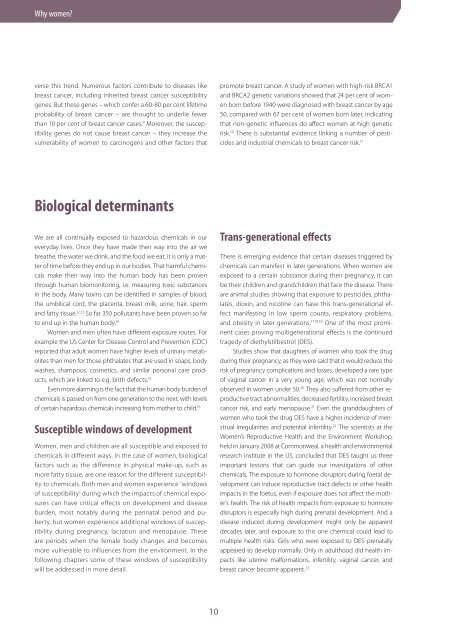Women and Chemicals
1ToENNR
1ToENNR
You also want an ePaper? Increase the reach of your titles
YUMPU automatically turns print PDFs into web optimized ePapers that Google loves.
Why women?<br />
verse this trend. Numerous factors contribute to diseases like<br />
breast cancer, including inherited breast cancer susceptibility<br />
genes. But these genes – which confer a 60-80 per cent lifetime<br />
probability of breast cancer – are thought to underlie fewer<br />
than 10 per cent of breast cancer cases. 9 Moreover, the susceptibility<br />
genes do not cause breast cancer – they increase the<br />
vulnerability of women to carcinogens <strong>and</strong> other factors that<br />
promote breast cancer. A study of women with high-risk BRCA1<br />
<strong>and</strong> BRCA2 genetic variations showed that 24 per cent of women<br />
born before 1940 were diagnosed with breast cancer by age<br />
50, compared with 67 per cent of women born later, indicating<br />
that non-genetic influences do affect women at high genetic<br />
risk. 10 There is substantial evidence linking a number of pesticides<br />
<strong>and</strong> industrial chemicals to breast cancer risk. 11<br />
Biological determinants<br />
We are all continually exposed to hazardous chemicals in our<br />
everyday lives. Once they have made their way into the air we<br />
breathe, the water we drink, <strong>and</strong> the food we eat, it is only a matter<br />
of time before they end up in our bodies. That harmful chemicals<br />
make their way into the human body has been proven<br />
through human biomonitoring, i.e. measuring toxic substances<br />
in the body. Many toxins can be identified in samples of blood,<br />
the umbilical cord, the placenta, breast milk, urine, hair, sperm<br />
<strong>and</strong> fatty tissue. 12,13 So far 350 pollutants have been proven so far<br />
to end up in the human body. 14<br />
<strong>Women</strong> <strong>and</strong> men often have different exposure routes. For<br />
example the US Center for Disease Control <strong>and</strong> Prevention (CDC)<br />
reported that adult women have higher levels of urinary metabolites<br />
than men for those phthalates that are used in soaps, body<br />
washes, shampoos, cosmetics, <strong>and</strong> similar personal care products,<br />
which are linked to e.g. birth defects. 15<br />
Even more alarming is the fact that the human body burden of<br />
chemicals is passed on from one generation to the next, with levels<br />
of certain hazardous chemicals increasing from mother to child. 16<br />
Susceptible windows of development<br />
<strong>Women</strong>, men <strong>and</strong> children are all susceptible <strong>and</strong> exposed to<br />
chemicals in different ways. In the case of women, biological<br />
factors such as the difference in physical make-up, such as<br />
more fatty tissue, are one reason for the different susceptibility<br />
to chemicals. Both men <strong>and</strong> women experience ‘windows<br />
of susceptibility’ during which the impacts of chemical exposures<br />
can have critical effects on development <strong>and</strong> disease<br />
burden, most notably during the perinatal period <strong>and</strong> puberty,<br />
but women experience additional windows of susceptibility<br />
during pregnancy, lactation <strong>and</strong> menopause. These<br />
are periods when the female body changes <strong>and</strong> becomes<br />
more vulnerable to influences from the environment. In the<br />
following chapters some of these windows of susceptibility<br />
will be addressed in more detail.<br />
Trans-generational effects<br />
There is emerging evidence that certain diseases triggered by<br />
chemicals can manifest in later generations. When women are<br />
exposed to a certain substance during their pregnancy, it can<br />
be their children <strong>and</strong> gr<strong>and</strong>children that face the disease. There<br />
are animal studies showing that exposure to pesticides, phthalates,<br />
dioxin, <strong>and</strong> nicotine can have this trans-generational effect<br />
manifesting in low sperm counts, respiratory problems,<br />
<strong>and</strong> obesity in later generations. 17,18,19 One of the most prominent<br />
cases proving multigenerational effects is the continued<br />
tragedy of diethylstilbestrol (DES).<br />
Studies show that daughters of women who took the drug<br />
during their pregnancy, as they were said that it would reduce the<br />
risk of pregnancy complications <strong>and</strong> losses, developed a rare type<br />
of vaginal cancer in a very young age, which was not normally<br />
observed in women under 50. 20 They also suffered from other reproductive<br />
tract abnormalities, decreased fertility, increased breast<br />
cancer risk, <strong>and</strong> early menopause. 21 Even the gr<strong>and</strong>daughters of<br />
women who took the drug DES have a higher incidence of menstrual<br />
irregularities <strong>and</strong> potential infertility. 22 The scientists at the<br />
<strong>Women</strong>’s Reproductive Health <strong>and</strong> the Environment Workshop,<br />
held in January 2008 at Commonweal, a health <strong>and</strong> environmental<br />
research institute in the US, concluded that DES taught us three<br />
important lessons that can guide our investigations of other<br />
chemicals. The exposure to hormone disruptors during foetal development<br />
can induce reproductive tract defects or other health<br />
impacts in the foetus, even if exposure does not affect the mother’s<br />
health. The risk of health impacts from exposure to hormone<br />
disruptors is especially high during prenatal development. And a<br />
disease induced during development might only be apparent<br />
decades later, <strong>and</strong> exposure to this one chemical could lead to<br />
multiple health risks. Girls who were exposed to DES prenatally<br />
appeared to develop normally. Only in adulthood did health impacts<br />
like uterine malformations, infertility, vaginal cancer, <strong>and</strong><br />
breast cancer become apparent. 23<br />
10


